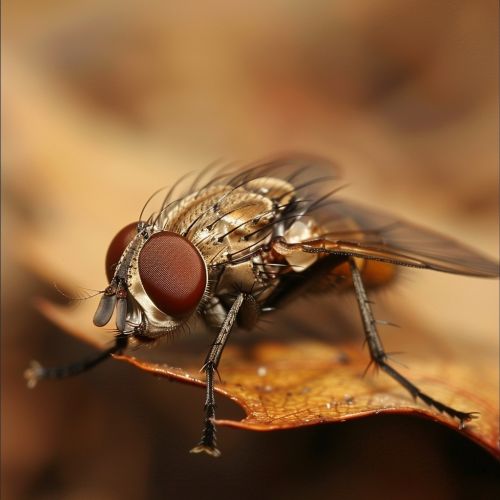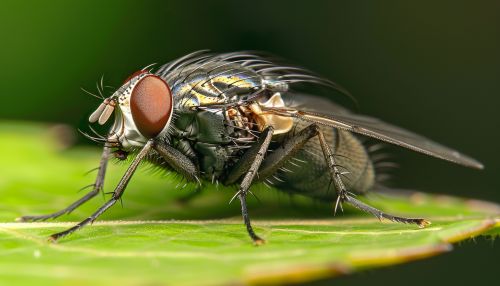Housefly
Introduction
The housefly (Musca domestica) is a fly of the suborder Cyclorrhapha. It is the most common of all domestic flies, accounting for about 91% of all flies in human habitations, and indeed one of the most widely distributed insects, found all over the world. It is considered a pest that can carry serious diseases.
Morphology
The adults are about 5–8 mm long. Their thorax is gray or sometimes even black, with four longitudinal dark lines on the back. The whole body is covered with hair-like projections. The females are slightly larger than the males, and have a much larger space between their red compound eyes. The mass of pupae can range from about 8 to 20 mg under different conditions. Like other Diptera, houseflies have only one pair of wings; the hind pair is reduced to small halteres that aid in flight stability. Characteristically, the media vein (M1+2 or fourth long vein) shows a sharp upward bend.
Life Cycle
Each female fly can lay approximately 500 eggs in several batches of about 75 to 150. The eggs are white and are about 1.2 mm in length. Within a day, larvae (maggots) hatch from the eggs; they live and feed on (usually dead and decaying) organic material, such as garbage or feces. They are pale-whitish, 3–9 mm long, thinner at the mouth end, and have no legs.
Ecology
Houseflies play a role in the chain of infection for certain diseases. Flies are attracted to food and other similar types of rubbish; they land on the rubbish and then visit places where human food is prepared or served. This gives them the opportunity to transfer pathogens from the rubbish to areas where humans are likely to be. Houseflies have a mutualistic relationship with the bacteria in their gut. The bacteria break down and digest the garbage that the fly eats, and the bacteria's feces serve as nutrients for the fly.
Diseases
Houseflies can carry pathogens, such as those causing typhoid, cholera, salmonellosis, bacillary dysentery, tuberculosis, anthrax, ophthalmia, and pyogenic cocci, which can cause sepsis and staphylococcus infections. A single fly can carry up to 1 million bacteria. This makes the housefly a dangerous carrier of pathogens, as it can easily contaminate food.
Control
Because they are so closely linked to human activity, houseflies are usually controlled with insecticides, physical barriers such as screens or netting, and by removing potential breeding sites. Insecticides can be used in bait, in a sugar and water solution, or as a contact poison. Since flies feed on garbage and feces, they can be controlled by proper sanitation practices.
See Also


